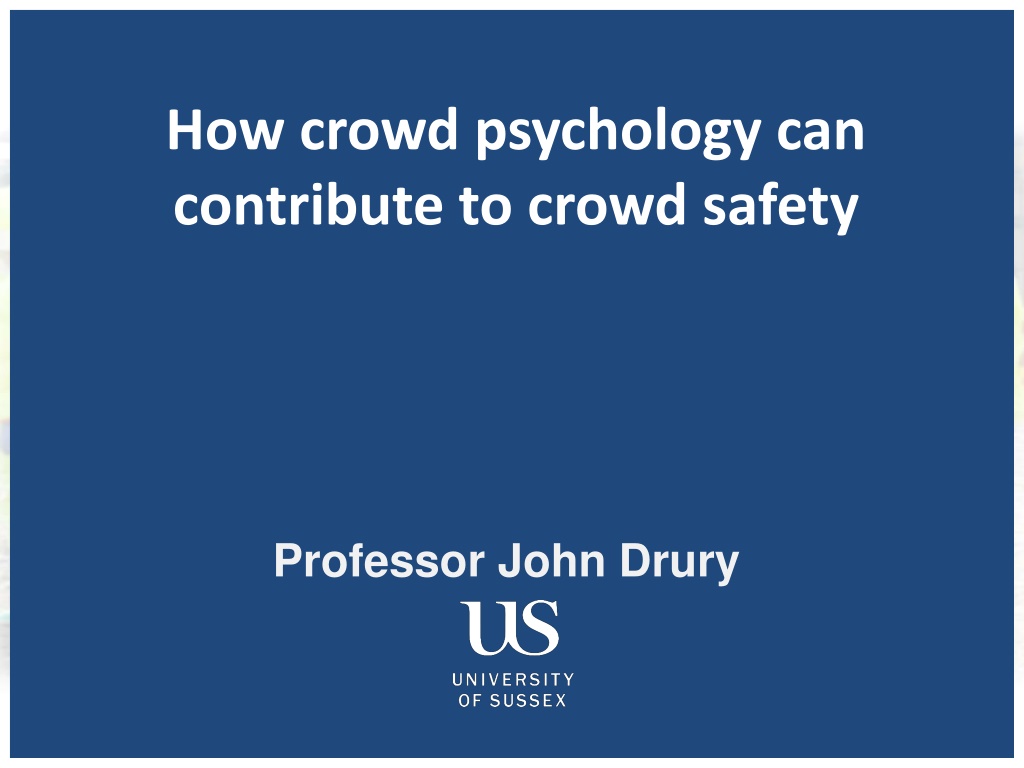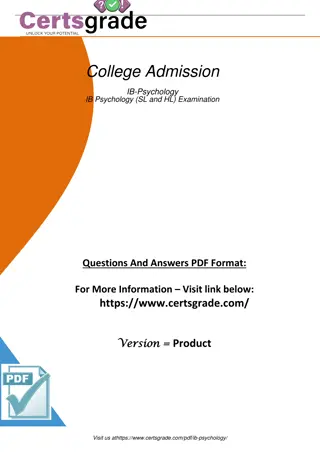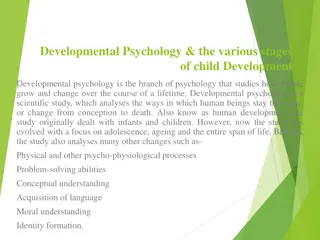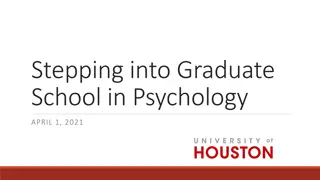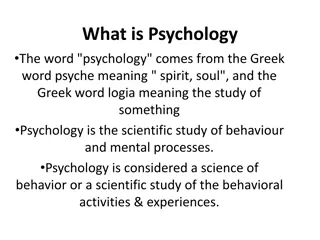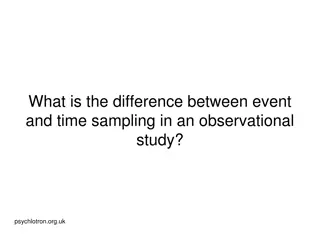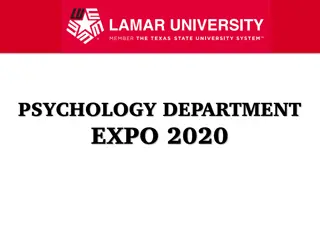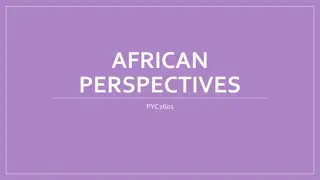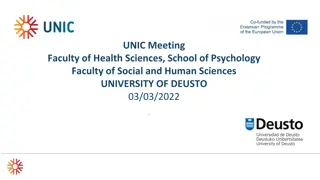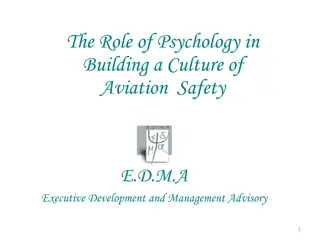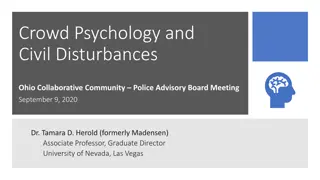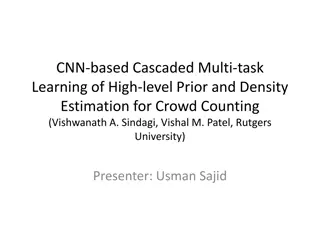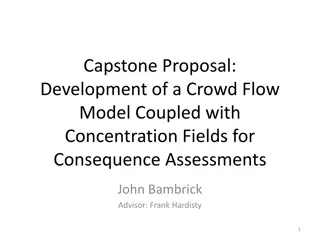Understanding the Role of Crowd Psychology in Enhancing Crowd Safety
Crowd psychology plays a crucial role in crowd safety by examining how collective behaviors, emotions, and identities can influence crowd dynamics. Professor John Drury's insights shed light on themes like heightened emotionality, lack of self-control, and collective resilience in crowds, as evidenced by real-life examples and literary references. By understanding crowd psychology, we can better manage and prevent potential risks in crowded situations.
Uploaded on Sep 08, 2024 | 1 Views
Download Presentation

Please find below an Image/Link to download the presentation.
The content on the website is provided AS IS for your information and personal use only. It may not be sold, licensed, or shared on other websites without obtaining consent from the author. Download presentation by click this link. If you encounter any issues during the download, it is possible that the publisher has removed the file from their server.
E N D
Presentation Transcript
How crowd psychology can contribute to crowd safety Professor John Drury
Overview 1. The crowd in representation and reality 2. Recap the social identity approach 3. Collective resilience in crowds: A near-disaster The Hajj
The crowd: recurrent themes: Crowds are characterized by: Heightened emotionality Emotionality instead of intelligence Mindlessness Primitive psychology People swept up , carried away or infected by the crowd Any spark ignites the crowd Lack of self-control Indiscriminate violence
Example of the crowd in literature: Shakespeare s Julius Caesar: The mob were whipped up by Mark Anthony s speech They murdered Cinna the Poet simply because his name was the same as that of one of the conspirators!
Case study: Food riots 1. Instinctual explosions, born out of desperation, expressing a basic need ? 2. Primitive, uncontrolled behaviours? E.P. Thompson: Analysis of around 700 English food riots (1750-1820).
Food riots 1. Born out of sheer desperation? The riots didn t happen at times of greatest shortage Riots happened when millers or merchants transgressed popular notions of how food should be distributed: hoarding food when it should be sold transporting food when it should be sold locally profiteering when food should be sold cheaply
Food riots 2. Primitive and uncontrolled behaviour? Seizure of food was typically discriminating Food riots were more punishment than theft: grain was seized sold at a popular price the money and often the grain sacks were handed back to the merchants!
Food riots "mixed crowds of ordinary people gather angrily before the shops of a miller, a merchant or a baker. They complain about prices, seize the food on hand and cart it off to the market square, sell it to all comers (so long as they belong to the community) at a price they declare to be just, turn over the cash to the owner of the grain or bread, and go home saying they have done justice, as the authorities themselves should have done justice" Tilly, C., Tilly, L. & Tilly, R. (1975) The rebellious century: 1830 - 1930. London: Dent.
Food riots Crowd behaviour was restrained, selective, disciplined and patterned, rather than being indiscriminate. How? Thompson (1971): food riots were based on a legitimizing notion shared by crowd participants a common belief that they were all defending (traditional) rights
Food riots Food rioters legitimizing notion was based on their moral economy : the popular consensus on obligations in relation to local needs opposed the emerging free market system (where goods are taken to wherever they can command the best price)
Social identity those aspects of an individual's self-concept based upon their social group or category memberships, together with their emotional, evaluative and other psychological correlates (Tajfel, 1978, p. 63)
Consequences: When there is shared social identity in a crowd There is more likely to be social support People give social support People expect social support Drury, Novelli & Stott (2014) Euro J Social Psych
Shared social identity makes coordination in a crowd easier Because there is shared understanding and expected support for valued group behaviour Mexican wave Queuing crowd
Identities and norms Each socialidentity has a different set of values and norms Norm= guide to conduct, what we regard as appropriate behaviour
Identities and norms Football match norms Lecture theatre norms Rules of the mosh pit only for those that identify!
A near disaster 250,000 people (60,000 expected) Emergency services overwhelmed Exit routes blocked Panic at DJ Fatboy Slim s Beach party seaside resort [brought] to the brink of disaster (Guardian, 21st July 2002)
A near disaster 1. Some people climbed up the lighting rigs 2. Part of the crowd was close to the waterline as the tide came in, a crowd surge as people tried to evacuate 3. Risk of crushing; some participants became distressed BUT it WASN T the disaster that people feared!
Research questions 1. To what extent did social identity processes in the crowd explain resilient outcomes (e.g., safety)? 2. How did the professional groups and crowd participants perceive that disaster was averted? Drury, Novelli, & Stott (2015) European Journal of Social Psychology
Methods Questionnaire survey (n = 48) Interviews Crowd participants (n = 10) Professional groups (n = 10) Contemporaneous archive data Video News reports Message-board material Official materials Written accounts by participants Drury, Novelli, & Stott (2015) European Journal of Social Psychology
Survey results Expecting others to help b = .54, p = .003 b = .60, p < .001 Crowd identification Feeling safe Direct effect, b = .23, p = .18 Indirect effect, b = .32, 95% CI [0.09, 0.69] Drury, Novelli, & Stott (2015) European Journal of Social Psychology
Survey results Trusting others in an emergency b = .71, p < .001 b = .54, p = .001 Crowd identification Feeling safe Direct effect, b = .17, p = .37 Indirect effect, b = .38, 95% CI [0.16, 0.74] Drury, Novelli, & Stott (2015) European Journal of Social Psychology
How was disaster averted? Steward perspective Crowd perspective Crowd self-organization : I m absolutely of the opinion that it was the crowd that stopped the disaster.. none of the barriers, none of the coppers, none of the stew.. stewards, none of the alleged things that were put into place .. to protect the crowd I don t think any of that mattered, I think it was the crowd that kept everything together (Crowd participant 4) Drury, Novelli, & Stott (2015) European Journal of Social Psychology
Working with the crowd building on and defining norms How are we going to get him down? So I said, you ask the voice of God [DJ Fatboy Slim], turn the music down, ask the voice of God very nicely to say [ ] please get down, because the party can t carry on until you re back on the ground, but do it safely please. Peer pressure will bring him down, and he won t get his head kicked in, and that will stop anybody else climbing up. Music came down, voice of God came over, he waved a bit, everyone cheered, and they re all going down, down, down , so he comes sliding all the way down, everyone cheers and that s it. No one else climbed a lamp post all night. (Council environmental health officer) Drury, Novelli, & Stott (2015) European Journal of Social Psychology
Hajj Mount Arafat
Hajj 2012 Holy Mosque: 356,800m2 (88.2 acres) Total capacity: two million* Average crowd density level of at least four people per square metre (4ppm2). However, at certain locations, levels of density as people get closer to the Kaaba = 6-8ppm2
Hajj How does an event which routinely reaches dangerous levels density pass without crushing incidents? Limited psychological research Mecca closed to non-Muslims
The study 1,194 pilgrims Languages groups: 420 (35%) were Arabic speakers, 150 (13%) of Malay, 150 (13%) of Urdu, 120 (10%) of French, 120 (10%) of Persian, 120 (10%) of Turkish, and 114 (9%) of English. Sampled across the three phases of the Hajj in which the Holy Mosque would be most busy. Alnabulsi & Drury (2014) Proceedings of the National Academy of Sciences
Measures Density people per square metre (researchers estimate) Safety (perceived) Identification with the crowd Perceived/expected social support Management competence Alnabulsi & Drury (2014) Proceedings of the National Academy of Sciences
Predictors of safety Identification with the crowd ( = 0.22, P < 0.001) Perceived support ( = 0.16, P < 0.001) Management competence ( = 0.132, P < 0.001) As density increased so safety decreased, = 0.061, P = 0.037. Alnabulsi & Drury (2014) Proceedings of the National Academy of Sciences
Results 1: moderation Alnabulsi & Drury (2014) Proceedings of the National Academy of Sciences
Results 2: mediation Perceived support b = .56, p < .001 b = .23, p < .001 Identification with the crowd Safety Direct effect, b = .41, p < .001 Indirect effect, b = .15, 95% CI [0.10, 0.20] Alnabulsi & Drury (2014) Proceedings of the National Academy of Sciences
Caveats Density (over 5ppm2) IS dangerous shock waves The argument is not that people never over-react to threats, but that crowds are not inherently the basis of over-reaction Not all crowds are characterized by social support Some crowds are divided; some crowds do not share social identity Social identity: the conditions for social support, not generic behaviours
Conclusions Social identification is the basis of: The social support and coordination needed to prevent disaster in potentially dangerous events This analysis has implications for how we think about crowd safety management Community Resilience: the community of circumstance
Acknowledgements Colleagues: Hani Alnabulsi, David Novelli, Clifford Stott Funders Leverhulme Trust, F/00 230/AO KSA cultural bureau Contact details j.drury@sussex.ac.uk Crowds and Identities research group: http://www.sussex.ac.uk/psychology/crowdsidentities/ @ProfJohnDrury
References Alnabulsi, H., & Drury, J. (2014). Social identification moderates the effect of crowd density on safety at the Hajj. Proceedings of the National Academy of Sciences, 111(25), 9091-9096. doi:10.1073/pnas.1404953111 Drury, J., Novelli, D., & Stott, C. (2015). Managing to avert disaster: Explaining collective resilience at an outdoor music event. European Journal of Social Psychology, 4, 533 547. doi: 10.1002/ejsp.2108 Thompson, E. P. (1971). The moral economy of the English crowd in the eighteenth century. Past & Present, 50, 76-136.
Overview and guidance readings Drury, J. (2018). The role of social identity processes in mass emergency behaviour: An integrative review.European Review of Social Psychology 29(1), 38-81. https://doi.org/10.1080/10463283.2018.1471948 Drury, J., Carter, H., Cocking, C., Ntontis, E., Tekin Guven, S., & Aml t, R. (2019). Facilitating collective psychosocial resilience in the public in emergencies: Twelve recommendations based on the social identity approach. Frontiers in Public Health, 7 (141) doi: 10.3389/fpubh.2019.00141
